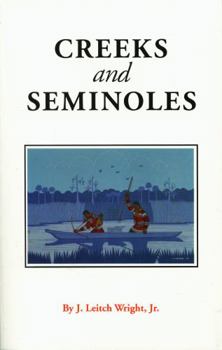Creeks and Seminoles: The Destruction and Regeneration of the Muscogulge People
Select Format
Select Condition 
Book Overview
During Andrew Jackson's time the Creeks and Seminoles (Muscogulges) were the largest group of Indians living on the frontier. In Georgia, Alabama, and Florida they manifested a geographical and... This description may be from another edition of this product.
Format:Paperback
Language:English
ISBN:0803297289
ISBN13:9780803297289
Release Date:September 1990
Publisher:University of Nebraska Press
Length:383 Pages
Weight:1.05 lbs.
Dimensions:0.9" x 5.5" x 8.5"
Customer Reviews
4 ratings
Best I've Seen on the Creek/Seminole "Nation" So Far
Published by Thriftbooks.com User , 16 years ago
There are quite a few works on the Indian tribes of the Southeast and on Indians more generally but this is the best I've read so far on the tribal group that came to be called the Creek nation who lived in what is today South Carolina, Georgia, Alabama and Florida. Meticulously describing and documenting the vast complexity that underlies this American Indian grouping, J. Leitch Wright clarifies how the Indians known in American history as the Creeks came into existence as the result of the shattering of the old Mississippian culture by the Spanish conquistadors in their march through the American southwest. The Muskogee peoples, Wright indicates, were the remnant groups of that culture who fled eastward and intermingled with various indigenous tribal groups (the Hitchiti speaking tribes) and other remnant groups who drifted southward. The Muskogee speakers were proud and numerous compared with the indigenous groups and other latecomers and so came to dominate those others. But the Muskogees were not, themselves, a single ethnic group because, at an earlier date, other remnant groups had sought and found shelter with them. The Muskogees did, however, have a sense of superiority over their Mississippian hangers-on who fled east with them (calling them "estinko" which entered the English language as "stinkards") and, unfortunately, they carried that attitude with them into the east. As a result, though the Indian settlements which came to be called "Creek" by the white colonists (possibly taking their name from a group of Hitchiti speakers called Ochese who gave their name to a small body of water where they lived, "Ochese Creek") were mixed from the beginning, the Muskogees tended to dominate. Wright traces the history from colonial to revolutionary to early republic times, showing how the disparate "Creek" groups (he calls them "Muscogulge") gradually split along the Muskogee/non-Muskogee divide with the non-Muskogees consisting of diverse Hichiti, Yuchi and even Shawnee groupings and the Muskogees consisting of the Mississipians and their estinko satellite peoples, agumented by other Indian groups who joined and were ultimately absorbed by them after their arrival in the east. All of this was made even more complex with the admixture of Africans who escaped the slavery of the English colonists (and later Americans). Because of the Indian practice in that part of the world of determining family relations matrilinearly (the wife and her children were counted as part of the wife's clan, the husband remaining with his own), many of the blacks who were offspring of mixed marriages were counted as tribal members through clan participation if their mother was a member of one of the Indian clans. But if Indian men took African women, who had no Indian clan, for wives, their children were counted as outside the Indian ethnic network. Thus children of mixed parentage could be considered either as Indians or outsiders. The ongoing influx of escaped slav
Creek Indians did not exist
Published by Thriftbooks.com User , 16 years ago
This book is very very interesting and well written. I had no idea that Creek indians did not really exist. The problem was that there were so many indian tribes in the southeast that the British could not keep them straight. Since most of them lived in villages next to creeks, the Brits just called them Creek Indians. The indians could not figure out why the Brits called them Creeks, but they went along anyway!Creeks and Seminoles: The Destruction and Regeneration of the Muscogulge People (Indians of the Southeast)
Older but great start to understanding these two groups
Published by Thriftbooks.com User , 16 years ago
Wright presents a classical study of the Muscogles and Muscogee nations (Seminoles and Creeks) in the era of colonization through removal. These tribes (which subdivide beyond the Indian names above) were primary located in the southeast mostly in Florida, Georgia and Alabama. Wright does an excellent job of looking at the complex factors that transformed these societies. From race relations with African slaves and whites to diplomacy between the empires, Wright looks at the evolution of these two groups. Ethnically and culturally the tribes differed greatly and although Europeans categorized them as Creeks and Seminoles. While more research has been done in recent years this is a great place to start with in order to gain an understanding of how these tribes interact. It is easy to read and thorough in its coverage of events and capturing the tribes culture and heritage.
EXCELLENT INFORMATION
Published by Thriftbooks.com User , 17 years ago
THE BOOK WAS VERY WELL WRITTEN WITH LOTS OF INFORMATION WITH ALL THE LATEST FACTS






